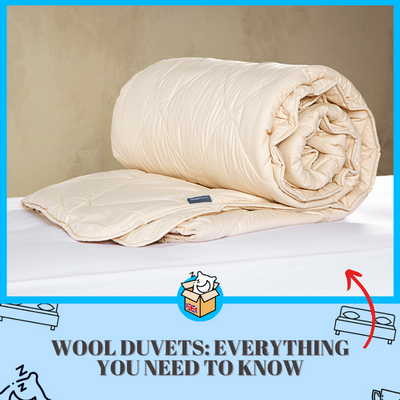Wool does have many super features, such as it naturally wicks the moisture from your body. Plus, your sleep environment will become allergy-free, as those pesky dust mites and allergens will not be able to survive in the wool environment.

Right, let’s go over some more frequently asked questions and cover the pros and cons.
What are the benefits of a wool duvet?
Wool duvets have many benefits over feather and synthetic duvets. Wool duvets can wick away moisture from your body, making you sleep more comfortably.
The wool duvet is extremely breathable. If you sleep hot, the wool duvet is an excellent choice.
The hyper-allergenic properties of wool duvets are incredibly high, which makes the wool duvets an absolute must for those who sleep and wake with allergies to things like dust mites.
Here are some pros and cons of wool duvets.
| Wool duvets pros | Wool duvet cons |
| Regulating body temperature for the ultimate sleep quality | Anyone who specifically suffers from an allergy to lanolin (the oil in the wool) – however many wool duvet manufacturers have actually removed this from their duvets. |
| Wicking away moisture from the body makes your sleep experience more pleasurable | Those wanting a very fluffy, soft duvet. A wool duvet is flatter and often a heavier choice. |
| Couples with different body temperatures If your partner sleeps cool and you sleep hot wool will compensate for the temperature variations | Smaller budgets: wool duvets tend to be more expensive than many synthetic duvets. |
| Long-lasting for years | |
| Environmentally friendly and sustainable, may also be organic | |
| Naturally flame retardant | |
| Resistant to dust mites, mildew, mould and water | |
| Not having to wash regularly – if washed, 30 degrees will get rid of allergens | |
| Not slipping off the bed (wriggly toddlers) | |
| Allergy sufferers – asthma, eczema, dust-mites |
Do bed bugs live in wool?
No, the environment is too harsh. Bed bugs love to breed in moist warm places, the opposite of a wool duvet.
Wool duvets wick away moisture that evaporates, keeping you dry through the night; wool duvets are breathable. They breathe easy and allow for air to flow while keeping you warm.
Bed bugs avoid wool as they cannot survive in this environment.
Is wool or feather or down better?
Wool duvets perform better than feather duvets. Everyone used to think that a feather-down duvet was the ultimate luxury for the bedroom.
However, the wool duvet knocks the feather duvets flying with superior benefits.
A wool duvet will regulate your body temperature, allowing you to sleep the whole night comfortably.
If your partner sleeps hot or cold, the wool duvets will compensate, so you both sleep at a temperature that suits you. In addition, most quality wool duvets have tie locks sewn in, so you can add another wool duvet of a different tog if required.
If you sleep, hot wool will naturally wick your skin’s moisture, keeping you cool.
Wool duvets are hypoallergenic and prohibit bacterial growth that may be associated with moisture.
Is a wool duvet good for kids?
After shearing, wool heads for a good wash, as you may expect. After all the dirt is removed, the wool is sanitised, with only a few chemicals added. It should be your first choice.
Did you know that wool is naturally fire retardant?
Wool duvets have incredible temperature regulation g properties that make them perfect for any child’s bed (not newborns).
If your child has allergies, the wool duvet is a must, it will not irritate eczema, and if your child has asthma that is made worse by dust mites, then you should know that dust mites cannot live in wool.
Are wool duvets heavy?
Yes, but reassuring heavy rather than oppressive heavy. There is no denying that wool duvets are weightier than their feather or synthetic counterparts.
Wool duvets have a reassuringly comforting weight that makes you feel like you are snuggled up and tucked in, ready for a good night’s sleep.
Which tog should you choose for your wool duvet?
It’s a personal choice. The nice thing about quality wool duvets is you can have two tog ratings depending on how you sleep. Your duvet can come with tie points, so you can add an additional duvet.
You would normally select a tog rating for your wool duvet based on the time of the year and the outside temperature. However, if you live in a home with great insulation and use the central heating when it’s cold, you may find a lightweight wool duvet will suffice.
- Lightweight – (300g/m2) – With an equivalent tog value between 3 and 7, this wool duvet is ideal for Spring, Summer, Autumn and, or for those who prefer a lighter weight and can be used all year round.
- Medium weight – (450g/m2) – With an equivalent tog value between 8 and 12, this wool duvet is suitable for autumn, winter, or those who prefer a heavier duvet. It can also be used all year round.
Because of the breathable nature of the wool duvet, you will find they are cool when it’s warm and hot when the temperature starts dipping towards freezing.
How do you wash a wool duvet?
It can be done in a domestic washing machine with a suitable weight rating. Washing your wool duvet is simplicity itself.
- Use a quality non-biological or wool detergent for best results
- You can machine wash on the coolest setting (30℃) or use the wool wash cycle for a gentle wash
- Use the slowest spin speed to prevent the wool fill from gathering in one area of the duvet
- If the weather is good, finish the process on a line; alternatively, dry indoors.
What sizes are available for wool duvets?
There is an ample amount of sizes comparable with all duvets. You can find the size you are looking for easily.
Below is a list of commonly sized wool duvets:
Wool Duvet sizes:
- Cot: 120cm x 140cm (47″ x 55″)
- Single: 140cm x 200cm (55″ x 78″)
- Double: 200cm x 200cm (79″ x 79″)
- King: 225cm x 220cm (89″ x 87″)
- Super King: 260cm x 220cm (102″ x 87″)
- Emperor: 290cm x 235cm (114″ x 92″)
 Nectar Mattress
Nectar Mattress 


